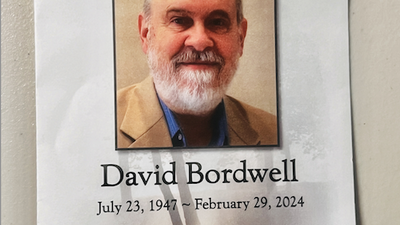Martin Scorsese famously said that cinema is a matter of what’s in the frame and what’s out–though, of course, it’s about lots of other things, including lighting, sound, music, performance, and design elements. Bordwell and Thompson’s interest was very much in that spirit. They cared about how stories were told, not just about what messages the film appeared to be sending, or whether it was in line with received political wisdom or part of a genre that was thought of as serious or respectable David loved canonical touchstones of art cinema such as “Tokyo Story” and “Hiroshima, Mon Amour,” but was also fascinated by red-meat genre fare. He appreciated the filmography of Craig S. Zahler, the right-leaning genre filmmaker behind “Brawl in Cell Block 99” and “Dragged Across Concrete,” as well as the energy and style of films by controversial action filmmakers from earlier eras, such as Sam Peckinpah. He loved Hong Kong action cinema so dearly that he gave lectures with titles like “Art of the Martial Arts Film.” In 2007, he received a special award “for excellence in scholarship on Asian Cinema” at the first Asian Film Awards, presented by Johnnie To. He had an inexhaustible appetite for new and previously unseen movies and fresh modes of visual storytelling. (Koepp quoted an email from David that urged film students, “Those movies won’t watch themselves!”)
Nobody was better at taking a movie apart and studying how it worked—as a story, as a meaning-generating engine, and as a visceral experience.
“David and I have studied films closely to determine what the stylistic and narrative norms are for a given period and place, and what films were innovative in relation to those norms,” Kristin told The Cine-Files, a cinema studies journal published by the Savannah College of Art and Design. “Rather than examining a single film closely, such an approach involves analyzing multiple films to find commonalities and divergences.”
Or as David wrote in 2020, “I’m interested in two questions: How do films work? How do they work on us? The first question, I think, can productively start with filmmaking craft and the norms that filmmakers work with in their historical situation. Within and against those norms, filmmakers create work that blends tradition and innovation. I’m interested in conventions–the conventional side of “unconventional” works, and the unconventional side of more apparently rule-abiding ones.”
Said Kim Hendrickson, executive producer for The Criterion Collection: “Beyond being the dean of American film studies, David was the best movie buddy anyone could want. His tastes were hugely eclectic, his passions ran deep, and his lifelong study of film form meant he could see what a film was really saying by studying how it was built, a kind of X-ray vision that allowed him to see the skeleton of a work…[He] contributed to the cinematic education of more film students than anyone I can think of. In the digital age, David embraced technology to expand access to genuine critical thinking about the movies, first with his invaluable, timeless, and free blog, ‘Observations on Film Art,’ and then when the Film Art team brought their brand of film school to The Criterion Channel for fifty 15-minute video lessons, which it remains our great honor to present.”

